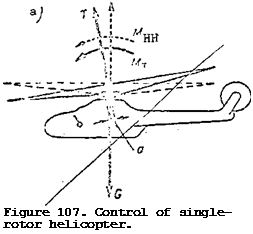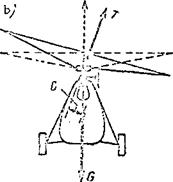Single-rotor Helicopter Control Principles
Helicopter control involves control of the rotation of the helicopter about its principal axes and control of the vertical displacement. On this basis the entire control complex considered as the sum of the pilot’s actions can be divided into longitudinal, lateral, and directional control, and also control of the up-and-down displacement of the helicopter. This division is purely arbitrary, since the pilot’s control actions are unified and are accomplished simultaneously and synchronously. However, this division facilitates study of the control question and corresponds to the construction of the control system, which includes four control loops which are independent of one another and are named the same as the names of the particular control modes.
Lontitudinal control is control of helicopter rotation about the transverse axis. It is achieved by the action on the helicopter of the longitudinal
control moments M, which are created with fore-and-aft deflection of the
zcont
cyclic pitch control stick. As a result of the tilt of the cone-of-revolution axis in the direction of the stick deflection, the main rotor thrust vector tilts. If prior to deflection of the stick the helicopter was in equilibrium, i. e., the thrust force moment was zero (Figure 107a), after forward deflection of the stick the cone-of-revolution axis deflects in the same direction. The thrust force vector passes at the distance a from the transverse axis and creates the thrust moment = Та, which will be a diving moment. In addition
to the thrust moment, the horizontal hinge diving moment Mjjj = Nc is created. The sum of these two moments creates the longitudinal control moment. The helicopter will be rotated about the transverse axis in the nose-down direction under the action of this moment. Aft deflection of the stick leads to the formation of a nose-up pitching moment, under the action of which the helicopter nose rises.
![]()
 |
 |
If the helicopter has longitudinal static stability, the rotation will continue until the stabilizer longitudinal moment balances the control moment. If the helicopter does not have static stability, it will be necessary to deflect the stick in the opposite direction to stop the rotation. As a result of helicopter rotation there is a change of the inclination of the thrust force vector and its horizontal component P. This leads to a change of the flight velocity. Hence we can conclude that forward deflection of the cyclic pitch stick leads to lowering of the helicopter nose and increase of the flight speed. Aft deflection of the stick leads to the helicopter nose rising and reduction of the flight speed. If the stick is moved aft while the helicopter is hovering, it will start to move backward. Therefore the operation of the cyclic pitch stick is analogous to the operation of the control stick in an airplane.
Lateral control refers to control of helicopter rotation about the longitudinal axis. Lateral control is accomplished by deflecting the cyclic pitch stick to the right or left. The main rotor coning axis and the thrust force vector tilt to the same side as the stick (Figure 107b). The deflection of the thrust force vector and the main rotor plane of rotation leads to creation of the lateral control moment as the sum of the moments of the thrust force and the horizontal hinges. The magnitude of the moment will be larger, the higher the main rotor rpm, the larger the stick deflection, and the lower the position of the helicopter center of gravity. Under the influence of the control moment, the helicopter will rotate until the stick is moved in the opposite direction.
Directional control refers to control of helicopter rotation about the vertical axis. The helicopter rotates about the vertical axis under the influence of the directional moment, which is created as a result of the difference of the main rotor reactive moment and the tail rotor thrust moment Mv = M – Mt. Change of the tail rotor thrust force and its moment about the helicopter vertical axis is accomplished by deflecting the directional control pedals. These pedals are coupled by linkage with the pitch change mechanism mounted on the tail rotor gearbox.
If the right pedal is pushed, the tail rotor pitch is increased. As a result of increase of the thrust force by the amount AT, its moment increases. The tail rotor thrust moment becomes greater than the main rotor reactive moment and the helicopter turns to the right. If the left pedal is pushed, the tail rotor pitch is reduced. In view of the decrease of the tail rotor thrust and moment, the latter becomes smaller than the main rotor reactive moment. Under the influence of this moment the helicopter turns to the left.











